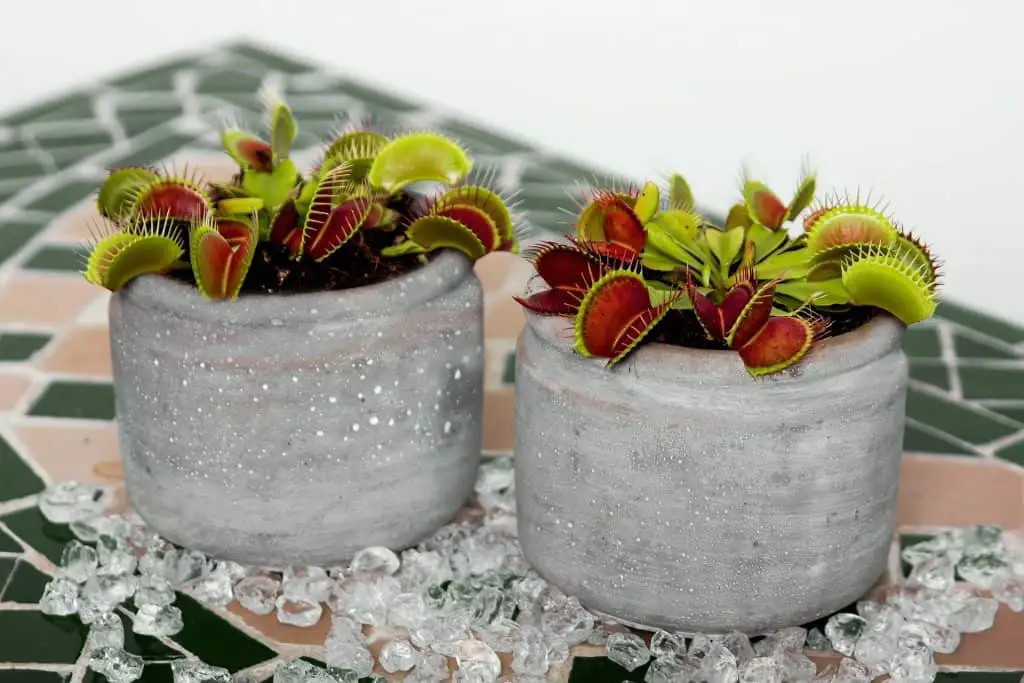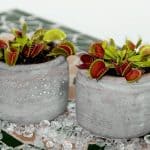Venus flytraps can be fantastic indoor or outdoor plants. They are beautiful, unique, and entertaining to own. When people consider growing Venus flytraps indoors, sometimes they question if these plants have any particular smell.
The Venus flytrap does not characterize by any particular smell. The traps of the plant secrete sweet nectar to attract prey, but that scent is undecipherable by humans. If your Venus flytrap smells, it might be caused by rotting soil, a rotting bulb, or insect carcasses.
If your plant is having some trouble and you are noticing unwanted scents, no worries. We can help you fix it! And for all the prospective new owners, do not get discouraged. Venus flytraps do not smell bad. When properly cared for, there is no odor.
Do Venus Flytraps Smell?
Venus flytraps can be grown indoors as they do not emit any unwanted smells. However, improper growing conditions can cause unwanted odor surrounding your Venus flytraps.
Natural Venus Flytrap Scent
Venus flytraps are carnivorous plants. They secrete sweet nectar inside their traps to lure potential victims.
The red color inside the traps together with the fruity scent confuses insects. Prey believes they have arrived at a flower, but instead, they end up becoming food.
The sweet scent produced by Venus flytrap can only be perceived at a tiny scale. Humans won’t be able to smell anything from Venus flytraps.
When I first learned about the trapping mechanisms of Venus flytraps, I was captivated. The sweet nectar trick seemed very neat. I even tried smelling the scent out of my Venus flytrap. But, as you just learned, I had no luck.

Unnatural Smells: Detect the Source
On some rare occasions, you might notice a bad smell surrounding your Venus flytrap. The scent might not be coming from your plant directly, but from some elements inside its grow container.
These are the leading causes of bad odors within your Venus flytrap plant or its environment:
- An insect’s body is slowly decomposing inside the pot
- The soil is holding bacteria or mold
- You have a root rot
Now, we will explain each item in detail. Go over the list below and determine which fits your case.
An insect’s body is slowly decomposing inside the pot:
Venus flytraps consume insects. In most cases, they trap a bug and seal it inside the lobes of the trap. Then, the plant continues to digest the insect using enzymes. This process does not emit any smell because the trap is closed shut. Yet, sometimes things do not go as expected.
Sometimes Venus flytraps consume large insects. When an insect is relatively large for the plant, and it sticks out of the trap or barely fits inside, then the plant might have trouble digesting the bug.
In those cases, the plant attempts to consume the prey, but it might be unsuccessful. In those scenarios, the plant abandons the effort and lets the whole trap and leaf wither. Then, the bug, still inside the trap will slowly decompose naturally. Unfortunately, in these circumstances, dead bugs can emit an odor.
The easier way to eliminate the smell is to trim the dead leaves and remove any insect remains.
The soil is holding bacteria or mold:
Depending on humidity indexes and the temperature, your soil might be holding bacteria or mold. Any of those agents can produce unwanted smells. Also, it is not healthy for your plant to live in moldy or infested soil.
When your plant is fully trimmed, and the soil is exposed, it is easy to smell it and detect unwanted scents. Also, try to think back when was the last time you repotted your plant. Maybe this is an excellent time to exchange the soil.
You have a root rot:
Venus flytraps require a lot of water to live and develop. They need moist soil at all times. But, Venus flytraps do not need boggy or swamp-like conditions. For example, overwatering venus flytrap can cause root rot.
Root rot emits a smell. When your plant has root rot, the bulb is slowly rotting and dying. It is a severe condition that can kill your Venus flytrap.
Sometimes the smell of root rot is not very clear because the rotting bulb is underground. You can dig the soil around the bulb of your plant or entirely remove your plant from the ground to check for root rot.
Once you can observe the bulb you can identify a root rot easily:
- The bub has a dark color or dark spots
- The rotting area stinks
- The affected area has a squishy texture
Root rot is dangerous for your plant as it will not stop and will eventually consume the whole bulb and roots. We have an article about Venus flytrap root rots and how to save your plant. If you are having this issue, follow the instructions in the section to save your precious flytrap:
How to Prevent Unwanted Smells in Your Venus Flytrap
In this section, we will explore solutions to prevent any bad smells within your plant’s pot and environment. These tips will also help you keep your Venus flytrap healthy.
Proper Feeding and Trimming
Sometimes large or improper prey gets stuck inside a Venus flytrap. But, in most cases, traps die with food inside them due to improper feeding. Venus flytrap owners tend to get too excited (especially as first-time growers) when feeding their new pet. Venus flytraps make two main mistakes during feeding: Improper prey size or improper food.
Follow these tips to properly feed your Venus flytrap and prevent any leaves from dying:
- Only feed insects or arachnids to your Venus flytrap: Please, do not experiment with human food such as meat, candy, bread, etc. Your plant won’t be able to digest it. Instead, the trap will die with the food inside of it. Then, the feed will decompose slowly while attracting bacteria and fungus.
- Feed your plant prey that fits inside the trap: Do not experiment with larger prey. Measure the bug before feeding your plant; make sure the bug is about 1/3 of the size of the trap. Larger insects won’t necessarily provide more nutrients. Also, when the plant can consume it in a reasonable amount of time, the trap will abandon the task and die. Then, you will be left with a dead bug’s corpse.
Trimming Tip: Keep an eye on the traps that are consuming prey. If you notice one of them is turning black, make sure to trim it and remove it. Then, you won’t encounter any unwanted scents.
Use the Proper Carnivorous Plant Soil
Prevent bacteria, mold, or fungus from developing in your soil by choosing the right soil elements for your plant. Most Venus flytrap owners use a special mix for their plants. Venus flytraps grow well on a combination of long-fibered sphagnum moss or sphagnum peat moss and sand or perlite.
Make sure to include one type of moss and sand or perlite. Sand and perlite both are great draining agents. They also break up the soil and provide a well-aired medium.
Prevent Stinky and Dangerous Root Rot
The smell of root rot is nor pleasant, but it can help you save your plant. The unwanted smell is a warning sign regarding the health of your plant. Follow this advice to prevent root rot:
- Repot your plant once every year: Take advantage of the dormancy period to do some plant maintenance. Exchange old soil from the pot, clean up the roots, and set in new soil. There is no need to do this too often, just once a year or year and a half.
- Do not over-water your plant: Some people have the misconception that Venus flytraps live in swamps, but that is not true. Venus flytraps need a moist ground; the soil shouldn’t be damped or flooding. Test the ground after you water and make sure it is not saturated with water.
- Use nutrient-free soil with good drainage: Drainage in the soil prevents water stagnation.
Final Thoughts
I hope you found this article useful. A bad smell surrounding your Venus flytrap is an alert toward a care mistake. Maybe it is improper feeding, or perhaps overwatering. Regardless of the cause, you should take action to save your plant.
It is perfectly normal to make mistakes when growing Venus flytrap. Do not get discouraged. Venus flytraps can be tricky!


